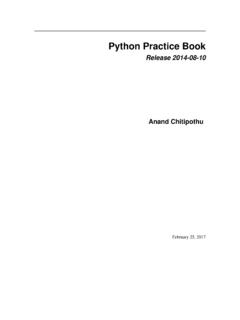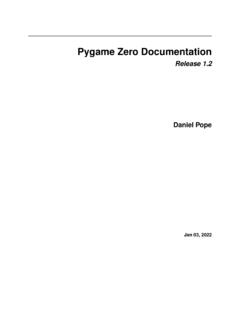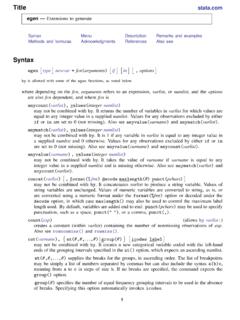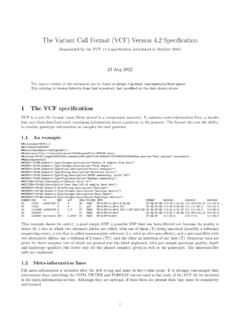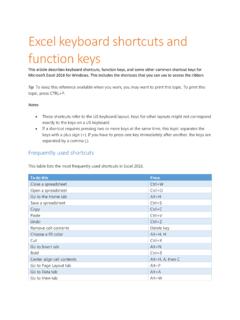Transcription of pdfminer - Read the Docs
1 pdfminer Release Levia3. Nov 18, 2017. Contents 1 PDFM iner 1. What's It? .. 1. How to Install .. 2. Command Line Tools .. 3. Changes .. 7. TODO .. 9. Related Projects .. 9. Terms and Conditions .. 9. 2 Programming with PDFM iner 11. Overview .. 11. Basic Usage .. 12. Performing Layout Analysis .. 13. Obtaining Table of Contents .. 15. Extending Functionality .. 15. i ii CHAPTER 1. PDFM iner Python PDF parser and analyzer Homepage Recent Changes PDFM iner API. What's It? PDFM iner is a tool for extracting information from PDF documents. Unlike other PDF-related tools, it focuses entirely on getting and analyzing text data. PDFM iner allows one to obtain the exact location of text in a page, as well as other information such as fonts or lines. It includes a PDF converter that can transform PDF files into other text formats (such as HTML). It has an extensible PDF parser that can be used for other purposes than text analysis. Features Written entirely in Python.
2 (for version or newer). Parse, analyze, and convert PDF documents. specification support. (well, almost). CJK languages and vertical writing scripts support. Various font types (Type1, TrueType, Type3, and CID) support. Basic encryption (RC4) support. PDF to HTML conversion (with a sample converter web app). Outline (TOC) extraction. Tagged contents extraction. Reconstruct the original layout by grouping text chunks. PDFM iner is about 20 times slower than other C/C++-based counterparts such as XPdf. 1. pdfminer , Release Online Demo: (pdf -> html conversion webapp). :8080/. Download Source distribution: github: Where to Ask Questions and comments: How to Install 1. Install Python or newer. (Python 3 is not supported.). 2. Download the PDFM iner source. 3. Unpack it. 4. Run to install: # python install 5. Do the following test: $ Hello World Hello World H e l l o W o r l d H e l l o W o r l d 6. Done! 2 Chapter 1. PDFM iner pdfminer , Release For CJK languages In order to process CJK languages, you need an additional step to take during installation: # make cmap python pdfminer /cmap Adobe-CNS1 cmaprsrc/cid2code_Adobe_.
3 Reading ' '.. writing ' '.. (this may take several minutes). # python install On Windows machines which don't have make command, paste the following commands on a command line prompt: mkdir pdfminer \cmap python tools\ -c B5=cp950 -c UniCNS-UTF8=utf-8 pdfminer \cmap Adobe-CNS1 cmaprsrc\ python tools\ -c GBK-EUC=cp936 -c UniGB-UTF8=utf-8 pdfminer \cmap Adobe-GB1 cmaprsrc\ python tools\ -c RKSJ=cp932 -c EUC=euc-jp -c UniJIS-UTF8=utf-8. pdfminer \cmap Adobe-Japan1 cmaprsrc\ python tools\ -c KSC-EUC=euc-kr -c KSC-Johab=johab -c KSCms- UHC=cp949 -c UniKS-UTF8=utf-8 pdfminer \cmap Adobe-Korea1 cmaprsrc\cid2code_. python install Command Line Tools PDFM iner comes with two handy tools: and extracts text contents from a PDF file. It extracts all the text that are to be rendered programmatically, text represented as ASCII or Unicode strings. It cannot recognize text drawn as images that would require optical character recognition. It also extracts the corresponding locations, font names, font sizes, writing direction (horizontal or vertical) for each text portion.
4 You need to provide a password for protected PDF documents when its access is restricted. You cannot extract any text from a PDF document which does not have extraction permission. Note: Not all characters in a PDF can be safely converted to Unicode. Examples $ -o (extract text as an HTML file whose filename is ). $ -V -c euc-jp -o (extract a Japanese HTML file in vertical writing, CMap is required). $ -P mypassword -o (extract a text from an encrypted PDF file). Command Line Tools 3. pdfminer , Release Options -o filename Specifies the output file name. By default, it prints the extracted contents to stdout in text format. -p pageno[,pageno,..]. Specifies the comma - separated list of the page numbers to be extracted. Page numbers start at one. By default, it extracts text from all the pages. -c codec Specifies the output codec. -t type Specifies the output format. The following formats are currently supported. text : TEXT format. (Default). html : HTML format.
5 Not recommended for extraction purposes because the markup is messy. xml : XML format. Provides the most information. tag : Tagged PDF format. A tagged PDF has its own contents annotated with HTML-like tags. pdf2txt tries to extract its content streams rather than inferring its text locations. Tags used here are defined in the PDF specification (See Tagged PDF ). -I image_directory Specifies the output directory for image extraction. Currently only JPEG images are supported. -M char_margin -L line_margin -W word_margin These are the parameters used for layout analysis. In an actual PDF file, text portions might be split into several chunks in the middle of its running, depending on the authoring software. Therefore, text extraction needs to splice text chunks. In the figure below, two text chunks whose distance is closer than the char_margin (shown as M) is considered continuous and get grouped into one. Also, two lines whose distance is closer than the line_margin (L) is grouped as a text box, which is a rectangular area that contains a cluster of text portions.
6 Furthermore, it may be required to insert blank characters (spaces). as necessary if the distance between two words is greater than the word_margin (W), as a blank between words might not be represented as a space, but indicated by the positioning of each word. Each value is specified not as an actual length, but as a proportion of the length to the size of each character in question. The default values are M = , L = , and W = , respectively. 4 Chapter 1. PDFM iner pdfminer , Release -F boxes_flow Specifies how much a horizontal and vertical position of a text matters when determining a text order. The value should be within the range of (only horizontal position matters) to + (only vertical position matters). The default value is -C. Suppress object caching. This will reduce the memory consumption but also slows down the process. -n Suppress layout analysis. -A. Forces to perform layout analysis for all the text strings, including text contained in figures.
7 -V. Allows vertical writing detection. -Y layout_mode Specifies how the page layout should be preserved. (Currently only applies to HTML format.). exact : preserve the exact location of each individual character (a large and messy HTML). normal : preserve the location and line breaks in each text block. (Default). loose : preserve the overall location of each text block. -E extractdir Specifies the extraction directory of embedded files. -s scale Specifies the output scale. Can be used in HTML format only. -m maxpages Specifies the maximum number of pages to extract. By default, it extracts all the pages in a document. -P password Provides the user password to access PDF contents. Command Line Tools 5. pdfminer , Release -d Increases the debug level. dumps the internal contents of a PDF file in pseudo-XML format. This program is primarily for debugging purposes, but it's also possible to extract some meaningful contents (such as images). Examples $ -a (dump all the headers and contents, except stream objects).
8 $ -T (dump the table of contents). $ -r -i6 > (extract a JPEG image). Options -a Instructs to dump all the objects. By default, it only prints the document trailer (like a header). -i objno,objno, .. Specifies PDF object IDs to display. comma - separated IDs, or multiple -i options are accepted. -p pageno,pageno, .. Specifies the page number to be extracted. comma - separated page numbers, or multiple -p options are accepted. Note that page numbers start at one, not zero. -r (raw). -b (binary). -t (text). Specifies the output format of stream contents. Because the contents of stream objects can be very large, they are omitted when none of the options above is specified. With -r option, the raw stream contents are dumped without decompression. With -b option, the decompressed contents are dumped as a binary blob. With -t option, the decompressed contents are dumped in a text format, similar to repr() manner. When -r or -b option is given, no stream header is displayed for the ease of saving it to a file.
9 -T. Shows the table of contents. -E directory Extracts embedded files from the pdf into the given directory. -P password 6 Chapter 1. PDFM iner pdfminer , Release Provides the user password to access PDF contents. -d Increases the debug level. Changes 2014/03/28: Further bugfixes. 2014/03/24: Bugfixes and improvements for fauly PDFs. API changes: () method is removed and no longer needed. A password is given as an argument of a PDFD ocument constructor. 2013/11/13: Bugfixes and minor improvements. As of November 2013, there were a few changes made to the PDFM iner API prior to October 2013. This is the result of code restructuring. Here is a list of the changes: PDFD ocument class is moved to PDFD ocument class now takes a PDFP arser object as an argument. () and () is removed. PDFPage class is moved to process_pdf function is implemented as 2013/10/22: Sudden resurge of interests. API changes. Incorporated a lot of patches and robust handling of broken PDFs.
10 2011/05/15: Speed improvements for layout analysis. 2011/05/15: API changes. () is added. 2011/04/20: API changes. LTPolygon class was renamed as LTCurve. 2011/04/20: LTLine now represents horizontal/vertical lines only. Thanks to Koji Nakagawa. 2011/03/07: Documentation improvements by Jakub Wilk. Memory usage patch by Jonathan Hunt. 2011/02/27: Bugfixes and layout analysis improvements. Thanks to 2010/12/26: A couple of bugfixes and minor improvements. Thanks to Kevin Brubeck Unhammer and Daniel Gerber. 2010/10/17: A couple of bugfixes and minor improvements. Thanks to standardabweichung and Alastair Irving. 2010/09/07: A minor bugfix. Thanks to Alexander Garden. 2010/08/29: A couple of bugfixes. Thanks to Sahan Malagi, pk, and Humberto Pereira. 2010/07/06: Minor bugfixes. Thanks to Federico Brega. 2010/06/13: Bugfixes and improvements on CMap data compression. Thanks to Jakub Wilk. 2010/04/24: Bugfixes and improvements on TOC extraction. Thanks to Jose Maria.


